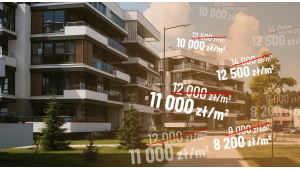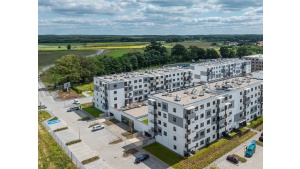Real estate will maintain the status quo
Prestige PR
Włodarzewska 81C lok 81
02-393 Warszawa
i.wisniewska|prestigepr.pl| |i.wisniewska|prestigepr.pl
508 927 958
www.prestigepr.pl
Forecasts for commercial real estate market in Poland
Bartłomiej Zagrodnik, Managing Partner, CEO of Walter Herz
Waiting for cheaper money
In 2023, Polish investment market, like foreign markets, saw low investor activity. The value of investment volumes in all real estate sectors was much lower than in previous years. Investors are waiting for an improvement in the macroeconomic situation and a decline in interest rates, they are looking for opportunities. The market is waiting for price stabilization and cheaper money. Until this happens, it is difficult to expect major changes.
Lower financing costs are expected to increase the value of investments and eliminate the differences between the price expectations of buyers and sellers. For now, however, the negotiation space between the parties to the transaction, in many cases, is still significant and encourages a creative approach to reckoning.
We observe that investors are looking for new forms of reckoning and alternatives to bank financing, creating investment alliances. Limited access to loans favors establishing partnerships and creating new areas for cooperation between developers and investors. Many entities optimize their strategies to make profit.
Investors are still interested in properties with attractive prices and locations, offering a good rate of return and value-add investments with the potential to increase their value through more effective lease management, or modernization, reconstruction and changes in utility function.
In 2024, market participants will continue to analyze the profitability of the properties in their portfolios and look for new opportunities. We can see that the Polish market is being observed by new investors who have not yet been present in Poland, such as developers, investors and financing entities, which is confirmed by, among others, recently announced transactions.
Office flexibility included
In recent years, we have seen a significant decline in new supply on the office market, both in Warsaw and on the largest regional markets. This year, we can expect this trend to continue. The activity of developers depends on the macroeconomic situation, the possibility of financing new projects and the demand for new offices. Meanwhile, on the regional markets, tenants are gradually optimizing the space they occupy and are cautious about relocation due to the high costs of fit-out. With the growing popularity of hybrid work, they are reducing their offices by an average of 25-30 per cent. Hence, in the largest regional cities in Poland, low developer activity will become the standard in the near future. In Warsaw, space in new projects is rented out quickly. Companies mainly choose central locations, and employees are most eager to return to offices out of all markets in Poland, which is why new, large office investments are initiated, such as Skyliner II, Office House in the Towarowa 22 complex, or Studio A.
In the upcoming years, tenants will be attracted primarily by centrally located, modern buildings providing good access to public transport and value-add solutions for employees. Office complexes that offer not only traditional space, but also co-working spaces, leisure zones and various types of services and amenities. High demand for flexible office spaces that can be quickly adapted to the changing needs of companies will remain. In response to the transformation of the working environment, developers and investors can offer more flexible lease terms and office spaces that can be easily rearranged. Due to cost optimization by tenants, building owners will focus on finding ways to reduce the costs of maintaining and operating the property.
Companies will move from older office buildings to newer and attractively located buildings. I expect that the demand for offices in Warsaw will maintain last year's good level this year, while lower demand for offices on the regional markets will result in a further increase in the amount of vacant space.
ESG criteria and sustainability standards are now becoming the basis for classifying and assessing real estate. The market shows a huge difference in the standard of buildings between top-class projects and outdated office buildings, which will be gradually demolished or adapted for other functions. Cost-ineffective office buildings will be replaced by modern projects. In the near future, other office buildings will certainly follow in the footsteps of Atrium International in Warsaw, which will be replaced by the modern Upper One, or Ilmet, which is scheduled for demolition.
Ecology and digitization of management processes
A wave of ecological and digital changes on the real estate market is coming. Investors and developers will focus on buildings with ecological certificates that offer solutions reducing operating costs. Banks are already pushing investors to build such projects by offering cheaper financing for them. Buildings adapted to EU requirements in terms of emission will also be chosen by investors who are now building primarily ‘green’ investment portfolios.
In the upcoming years, market regulations will force owners to modernize older buildings that are currently not energy efficient. In addition to the increase in energy prices, the ETS2 system of CO2 emission fees, which is already in force in the industry and will also cover transport and real estate, will also contribute to improving the buildings. The EU directive on this matter will probably come into force in 2026 and we will have two years to implement it. First, non-residential, commercial and public buildings will be covered by the new regulations. From 2028, commercial buildings will have to be built in accordance with zero-emission policy, and in 2030, the requirement will also cover residential buildings.
Solutions using artificial intelligence will improve the analysis of sensor data and will optimize the use of space and increase the efficiency of buildings, which will effectively translate into additional sources of revenue for developers. Based on data analysis, artificial intelligence will also enter such areas as asset valuation, market analysis and tenant management, which will facilitate investment decision-making.
Smaller commercial formats on the front foot
Investments in the retail sector in recent years have been dominated by retail parks and convenience centers, which account for over 80 per cent of new projects. What is more, probably not much will change on the retail market in this respect in the near future. Approximately 470 thousand sq m. of commercial space is under construction across the country, implemented mainly in smaller formats, local retail parks, which are being built mainly in small towns. New supply in the commercial sector reached approximately 450 thousand sq m. of space in 2023. We can expect similar results this year.
The upcoming time in the retail sector will also be a period of the owners of older facilities making decisions about modernization and reconstruction, as was the case with Bonarka in Cracow, or changing their functions, as evidenced by Arkady Wrocławskie or Galeria Malta in Poznan.
Owners of shopping complexes will continue to focus on optimizing property maintenance costs and aspects related to ESG, emission and solutions ensuring savings.
Investors’ interest in this sector, as in the case of other asset classes, focuses on smaller facilities, opportunities and projects with the potential to increase value as a result of reconstruction or management optimization.
Optimistic forecasts for warehouses
After years of market prosperity, the warehouse real estate sector in Poland will slow down in 2023. However, its rebound is expected. This is a very likely scenario when we look at the sector's prospects in the context of Poland's role in the global transformation of the organization of supply chains and the transfer of processes from Asia to Europe. Optimistic forecasts and an opportunity for the development of the Polish industrial and warehousing sector are also brought by the rapid increase in demand for semiconductors and the European Chips Act, which assumes doubling of the share of EU countries in the global production of semiconductors by 2030.
The increase in automotive production in Poland, mainly electric cars and batteries, will also contribute to the further development of the sector. Several large investments in the area of electro mobility have already been announced and are to be launched soon.
The resources of the Polish warehouse market have been growing rapidly in recent years, and three more locations with modern logistics facilities have joined the group of the five largest markets. Therefore, we have appropriately developed resources. Moreover, the infrastructure for sea transport is being developed in Gdansk, Gdynia and Swinoujscie, which will also influence further industrial investments and further development of logistics.
However, this year, excessive requirements related to obtaining financing for new projects will continue to limit the implementation of speculative investments and favor safe projects with pre-lease agreements. An increase in the vacancy rate in the industrial market in 2023, will probably cause developers to limit their plans this year. The new supply brought to the sector in 2024, may be lower than registered last year, due to lower demand and high rental rates. Rents in modern urban warehouses located in the vicinity of the largest agglomerations may continue to increase due to the continued high demand and shortage of such space.
Last year, the warehouse sector returned to the leading position on the investment market, recording the highest value of transaction volume. However, its size was much lower than in previous years. The return of global investors and increased liquidity in this and other sectors depends on the improvement of the macroeconomic situation.

Łotewski producent wysokiej jakości domów prefabrykowanych wchodzi na polski rynek

Deweloperzy ukrywają ceny mieszkań. Z troski o klientów czy swoje portfele?

Więcej przestrzeni, mniej hałasu – dlaczego Polacy coraz częściej wybierają przedmieścia?
Więcej ważnych informacji
 Jedynka Newserii
Jedynka Newserii

 Jedynka Newserii
Jedynka Newserii

Handel

Mercosur to tylko wierzchołek góry lodowej. UE ma ponad 40 umów handlowych, które mogą destabilizować rynek rolny
Umowa handlowa między UE a krajami Mercosur może znacząco zaburzyć konkurencję na rynku rolnym i osłabić pozycję unijnych, w tym polskich, producentów – ostrzegają rolnicy i producenci żywności. Umowie sprzeciwia się część krajów unijnych, które domagają się klauzuli ochronnych oraz limitów importowych. – Problemem jest jednak nie tylko ta konkretna umowa. Chodzi o cały system wolnego handlu, który się kumuluje z dziesiątek innych porozumień – podkreśla Andrzej Gantner, wiceprezes Polskiej Federacji Producentów Żywności.
Firma
Dzięki zdalnej weryfikacji tożsamości z wykorzystaniem AI firmy zminimalizowały liczbę oszustw. Rozwiązania wykorzystuje głównie sektor finansowy

Z najnowszych danych Eurostatu wynika, że w 2024 roku 5,9 proc. polskich firm korzystało z rozwiązań z zakresu sztucznej inteligencji. W 2023 roku był to odsetek na poziomie 3,67 proc. Wciąż jednak jest to wynik poniżej średniej unijnej, która wyniosła 13,48 proc. Jednym z obszarów, który cieszy się coraz większym zainteresowaniem wśród przedsiębiorców, jest weryfikacja tożsamości przez AI, zwłaszcza w takich branżach jak bankowość, ubezpieczenia czy turystyka. Jej zastosowanie ma na celu głównie przeciwdziałać oszustwom i spełniać wymogi regulacyjne.
Prawo
Daniel Obajtek: Własne wydobycie i operacyjne magazyny to filary bezpieczeństwa. Zgoda na magazyny gazu poza krajem to rezygnacja z suwerenności energetycznej

Były prezes Orlenu ostrzega przed zmianami w ustawie o zapasach ropy naftowej, produktów naftowych i gazu ziemnego. Jego zdaniem przygotowana przez rząd nowelizacja tzw. ustawy magazynowej i ujednolicanie unijnej polityki energetycznej to zagrożenie dla bezpieczeństwa energetycznego Polski. W jego opinii tylko silna spółka narodowa, własne wydobycie, krajowe magazyny i zbilansowany miks energetyczny zapewnią Polsce bezpieczeństwo i konkurencyjność.
Partner serwisu
Szkolenia

Akademia Newserii
Akademia Newserii to projekt, w ramach którego najlepsi polscy dziennikarze biznesowi, giełdowi oraz lifestylowi, a także szkoleniowcy z wieloletnim doświadczeniem dzielą się swoją wiedzą nt. pracy z mediami.





![Nestlé w Polsce podsumowuje wpływ na krajową gospodarkę. Firma wygenerowała 0,6 proc. polskiego PKB [DEPESZA]](https://www.newseria.pl/files/1097841585/fabryka-nesquik_1,w_85,r_png,_small.png)



.gif)

 |
| |
| |
|